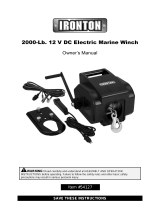Badland Item 61605 is a powerful winch designed for ATV/UTV applications. With a rated single line pull of 5,000 lb (2268 kg), it can handle heavy loads with ease. The 12VDC 3.8 HP permanent magnet motor provides ample power, while the 3-stage planetary geartrain and 165:1 gear ratio ensure smooth and efficient operation. The freespool cam activated mechanism allows for easy disengagement of the wire rope, while the auto load holding mechanical brake provides reliable load control. The winch comes with a 12 ft (3.7m) wired pendant controller and an 8 ft (2.
Badland Item 61605 is a powerful winch designed for ATV/UTV applications. With a rated single line pull of 5,000 lb (2268 kg), it can handle heavy loads with ease. The 12VDC 3.8 HP permanent magnet motor provides ample power, while the 3-stage planetary geartrain and 165:1 gear ratio ensure smooth and efficient operation. The freespool cam activated mechanism allows for easy disengagement of the wire rope, while the auto load holding mechanical brake provides reliable load control. The winch comes with a 12 ft (3.7m) wired pendant controller and an 8 ft (2.
















-
 1
1
-
 2
2
-
 3
3
-
 4
4
-
 5
5
-
 6
6
-
 7
7
-
 8
8
-
 9
9
-
 10
10
-
 11
11
-
 12
12
-
 13
13
-
 14
14
-
 15
15
-
 16
16
Badland 61605 Owner's manual
- Type
- Owner's manual
- This manual is also suitable for
Badland Item 61605 is a powerful winch designed for ATV/UTV applications. With a rated single line pull of 5,000 lb (2268 kg), it can handle heavy loads with ease. The 12VDC 3.8 HP permanent magnet motor provides ample power, while the 3-stage planetary geartrain and 165:1 gear ratio ensure smooth and efficient operation. The freespool cam activated mechanism allows for easy disengagement of the wire rope, while the auto load holding mechanical brake provides reliable load control. The winch comes with a 12 ft (3.7m) wired pendant controller and an 8 ft (2.
Ask a question and I''ll find the answer in the document
Finding information in a document is now easier with AI
Related papers
-
Badland ZXR 9500 Owner's manual
-
Badland Item 63770 Owner's manual
-
Badland Item 61840-UPC 193175324153 Owner's manual
-
Badland Item 61604 Owner's manual
-
Badland Item 63770-UPC 193175345493 Owner's manual
-
Badland 63770 Owner's manual
-
Badland Item 56326-UPC 193175445230 Owner's manual
-
Badland Item 63139 Owner's manual
-
Badland 61840 Owner's manual
-
Badland 61383 Owner's manual
Other documents
-
ZEAK 4500-LB Owner's manual
-
ZEAK 5500 lb Synthetic Rope Winch Owner's manual
-
X-BULL 14500 LBS Capacity OFF-Road Vehicle Winch User manual
-
Uriah Products 12000lb Lbs. 12V-DC Electric Winch Owner's manual
-
X-POWER X-POWER XP-35 Powersports Winches Owner's manual
-
 Ironton 12 Volt DC Powered Electric Marine Winch Owner's manual
Ironton 12 Volt DC Powered Electric Marine Winch Owner's manual
-
X-BULL LT3000 ATV 3000 Ib 12 Volt DC Electric Winch Owner's manual
-
Harbor Freight Tools 12000 lb. Off_Road Vehicle Electric Winch with Automatic Load_Holding Brake User manual
-
Harbor Freight Tools 9000 lb. Off_Road Vehicle Electric Winch with Automatic Load_Holding Brake User manual
-
 Endurance Marine EMD2000SS Owner's manual
Endurance Marine EMD2000SS Owner's manual

















